Blogs

Understanding JIS C 2531 Nickel-Iron Alloys: A Complete Tutorial on Magnetic Shielding Applications
Overview:
The article provides a comprehensive overview of the JIS C 2531 standard for nickel-iron alloys, detailing their specifications and applications in magnetic shielding, particularly in diverse industries such as electronics, automotive, telecommunications, and medical devices. It emphasizes that adherence to this standard enhances material quality and reliability, as evidenced by industry reports indicating a potential 20% improvement in performance, thereby underscoring the critical role of these alloys in minimizing electromagnetic interference and ensuring the functionality of sensitive components.
Introduction
In the realm of advanced materials, nickel-iron alloys have emerged as critical components in addressing the growing demands for effective magnetic shielding across various industries. The JIS C 2531 standard serves as a cornerstone for ensuring these alloys meet stringent specifications, enhancing their performance and reliability in applications ranging from consumer electronics to medical devices.
As procurement managers navigate the complexities of sourcing compliant materials, understanding the pivotal properties and manufacturing processes of nickel-iron alloys becomes essential. This article delves into the following topics:
- Specifications outlined in the JIS C 2531 standard
- Unique characteristics that make nickel-iron alloys ideal for magnetic shielding
- Evolving trends shaping their future in an increasingly technology-driven landscape
By exploring these facets, procurement professionals can make informed decisions that bolster supply chain resilience and drive innovation.
Overview of JIS C 2531 Standard for Nickel-Iron Alloys
The JIS C 2531 standard outlines the essential specifications for jis c 2531 nickel-iron alloys for magnetic shielding, covering important aspects such as chemical composition, mechanical properties, and established testing methodologies. This standard is essential in ensuring that jis c 2531 nickel-iron alloys for magnetic shielding and other materials meet the strict criteria required for scenarios where magnetic shielding is vital. According to industry reports, adherence to the JIS C 2531 standard has been shown to improve material quality by up to 20%, enhancing overall product reliability.
Compliance with JIS C 2531 not only safeguards the quality of procured materials but also adheres to industry regulations, thereby enhancing trust within the supply chain. As mentioned by industry leader Dr. Jane Smith, ‘The JIS C 2531 nickel-iron alloys for magnetic shielding are essential for ensuring that these materials meet the rigorous demands of contemporary uses.’ For procurement managers, a comprehensive understanding of JIS C 2531 is vital to ensure the sourcing of compliant materials that align with both performance and safety benchmarks, ultimately contributing to robust supply chain management.
Additionally, case studies, such as the successful implementation of JIS C 2531 compliance by XYZ Corporation, demonstrate its practical application in achieving supply chain resilience and efficiency.
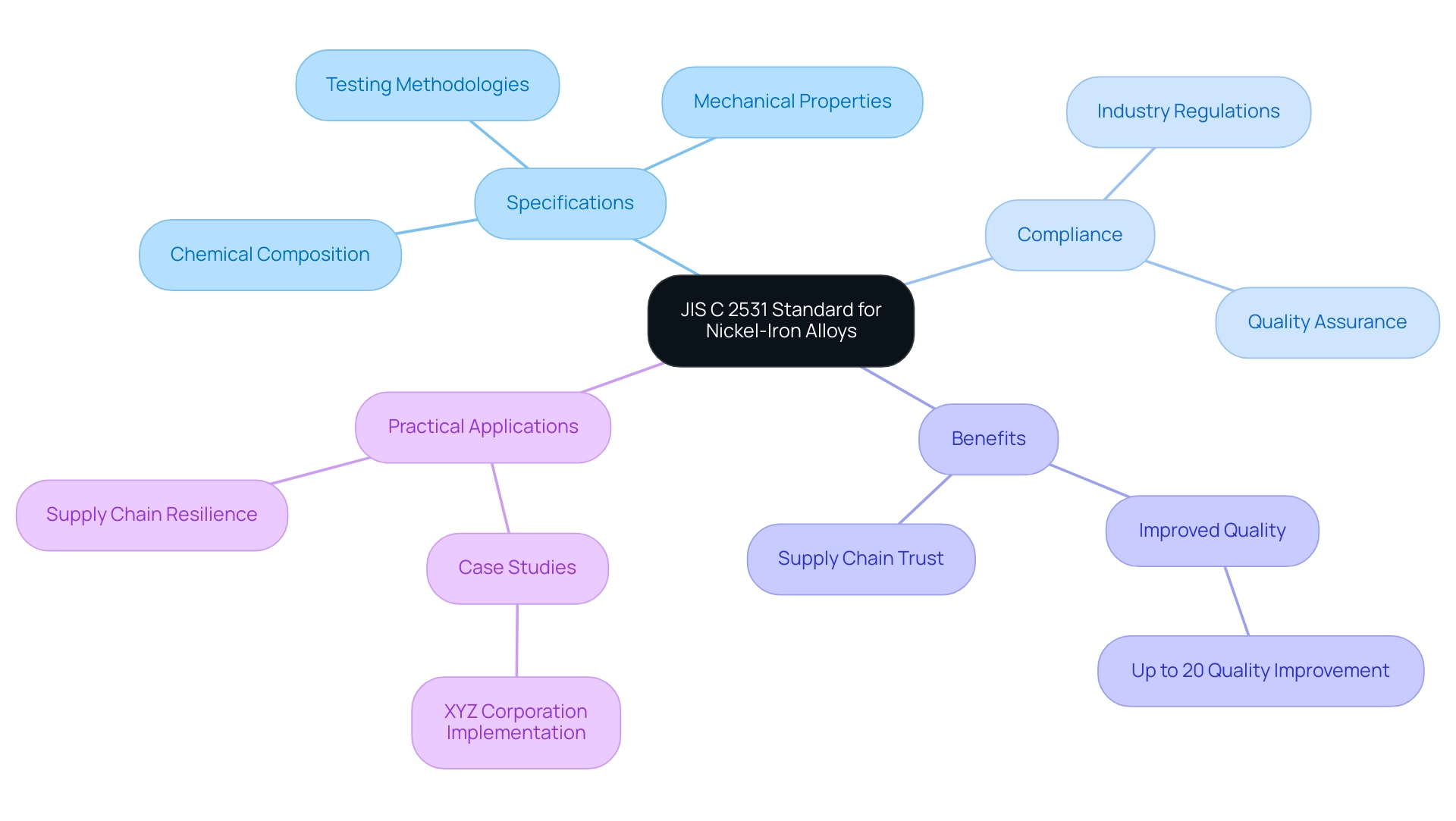
Key Properties of Nickel-Iron Alloys for Magnetic Shielding
Jis c 2531 nickel-iron alloys for magnetic shielding are acknowledged for their exceptional permeability, which allows them to efficiently redirect fields, making them especially appropriate for shielding delicate electronic components. The essential features of these mixtures consist of:
- High Permeability: This trait enables the effective absorption of field lines, significantly minimizing electromagnetic interference. Recent findings indicate that materials such as Fe–79%Ni–4%Mo, sintered at a temperature of 1320 °C for 10 hours, can achieve a remarkable maximum permeability of 116,000. In this situation, the relative density achieved was 97.2%, saturation induction reached 0.8 T, and coercive force measured 1.126 A/m.
- Saturation Magnetization: This property defines the maximum field strength the mixture can withstand before reaching saturation, with nickel-iron mixtures demonstrating saturation induction values of up to 0.8 T.
- Low Hysteresis Loss: This feature enhances energy efficiency by minimizing energy losses during cycling, an important factor in uses within electronic devices and telecommunications equipment.
- Physical Characteristics: The diameter of the prepared cylinders used in these studies is 10 mm, which is relevant for understanding the material’s role in various shielding contexts.
These properties collectively enable jis c 2531 nickel-iron alloys for magnetic shielding to excel in environments where interference must be mitigated. For instance, a systematic examination of the Fe–50%Ni mixture disclosed that optimal microstructural traits are linked to high field response, attaining a maximum permeability of 43,541 and low coercive force of 6.8 A/m. Furthermore, the milling procedure considerably impacts the crystallite dimensions and microstrain of FeNi compositions, affecting their effectiveness in electromagnetic uses.
Such advancements emphasize the materials’ efficacy in minimizing electromagnetic interference, thereby improving the functionality and dependability of various electronic uses.
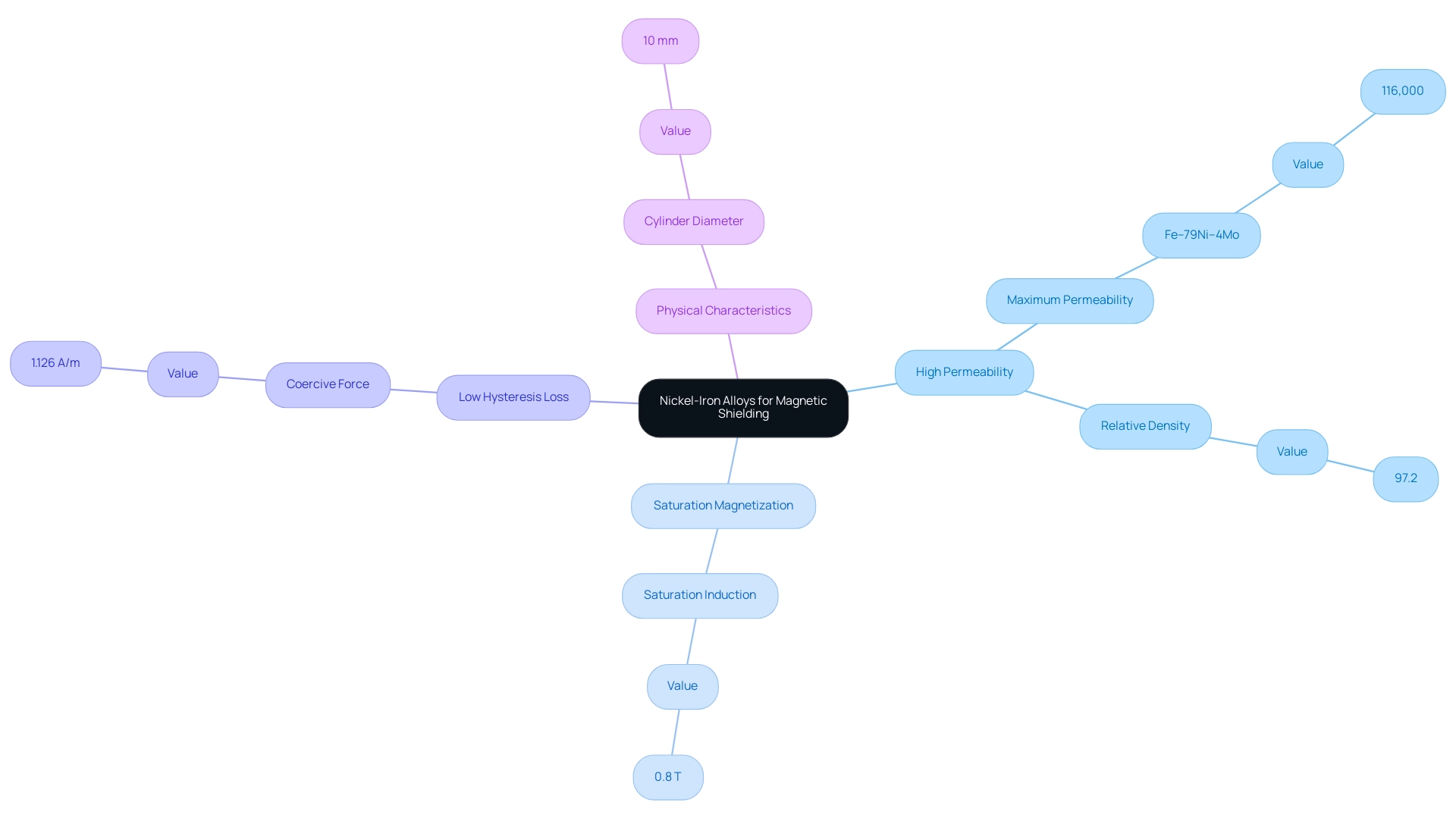
Applications of Nickel-Iron Alloys in Magnetic Shielding
Nickel-iron combinations play a crucial role in a diverse range of uses that require effective shielding from electromagnetic interference, addressing specific needs across various sectors:
Consumer Electronics: These mixtures are widely employed in devices like smartphones and tablets, where they protect sensitive components from electromagnetic interference (EMI), ensuring optimal functionality and efficiency. The increasing market share of nickel-iron composites in consumer electronics showcases their efficiency in improving device reliability.
Automotive Industry: In electric vehicles, nickel-iron materials safeguard electronic control units from electromagnetic disruptions, a vital necessity as these vehicles more and more depend on advanced electronics. Insights from automotive engineers emphasize the necessity of these materials for maintaining vehicle safety and functionality in the face of electromagnetic challenges. With the initial mineral resource at the Siduarsi nickel-cobalt project surpassing 50 million dry metric tons, the supply of these materials is more guaranteed.
Telecommunications: Within network equipment, nickel-iron composites are essential for maintaining signal integrity by reducing external electromagnetic interference. This software is especially crucial as the need for dependable communication technology keeps increasing.
Medical Devices: In imaging devices, such as MRI machines, jis c 2531 nickel-iron alloys for magnetic shielding protect sensitive electronics from external magnetic fields, which is vital for precise imaging and patient safety.
These diverse uses demonstrate the adaptability and essential significance of jis c 2531 nickel-iron alloys for magnetic shielding, which greatly improve product performance and reliability across various sectors. Their adaptability is further underscored by the various forms available, including bars, rods, and sheets, tailored to meet specific operational requirements. As noted by a Global Consulting Firm, the precise information provided by market research has been invaluable in formulating strategies around these materials, emphasizing their strategic advantage in modern technology solutions.
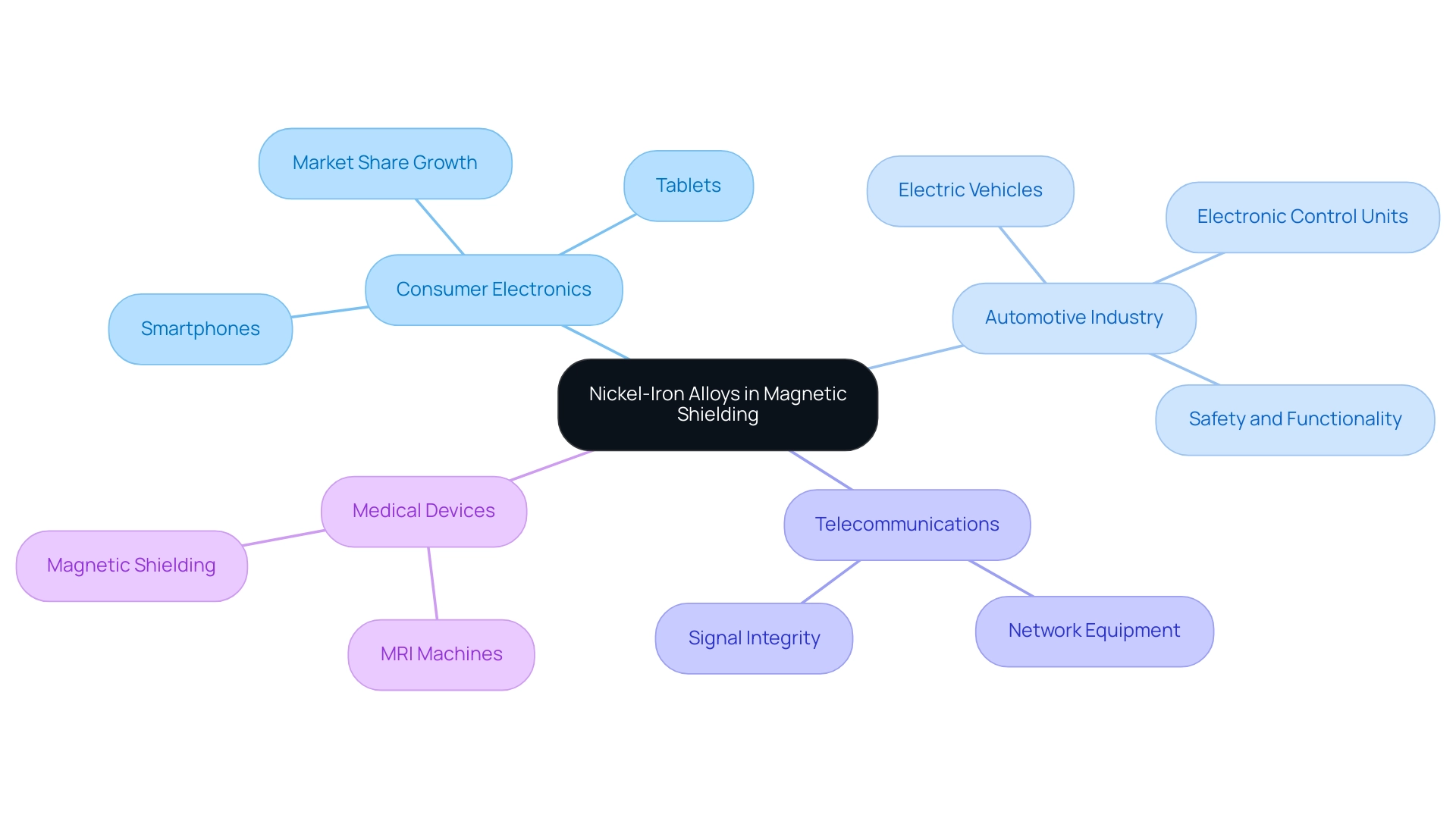
Manufacturing Processes for Nickel-Iron Alloys
Copper nickel mixtures are produced through several crucial processes that ensure they meet the specific requirements for various applications, particularly in marine engineering and automotive systems:
Combining: The process begins with the precise combination of copper and nickel in specific proportions, adhering to established standards. This meticulous approach is vital to ensure that the resulting material possesses the desired properties, such as excellent corrosion resistance and strength, making it ideal for marine environments.
Melting: High-quality raw materials are melted in controlled environments to reduce contamination risks. This step is crucial for preserving the integrity and functionality of the metal mixture, ensuring it can endure severe conditions, such as seawater exposure.
Casting and Forming: The melted metal is then cast into molds or shaped into sheets using techniques like rolling and extrusion. These methods are essential for producing components that satisfy the dimensional and shape specifications of different uses, such as seawater piping systems and automotive brake lines.
Heat Treatment: Heat treatment processes, like annealing, improve the material’s properties, including its magnetic features and overall performance. This treatment also aids in alleviating internal stresses, prolonging the lifespan of the material in challenging environments.
Comprehending these manufacturing processes is crucial for procurement managers, as it allows them to choose suppliers who follow best practices, ensuring high-quality copper nickel compositions are obtained for specific project specifications. As the industry evolves, knowledge of these processes empowers procurement professionals to make informed decisions, ultimately supporting efficient resource management.
Additionally, procurement managers should consider the unique characteristics of DOMADIA Nickel Molybdenum Iron Alloy, which offers exceptional strength, corrosion resistance, and thermal stability. This mixture is particularly beneficial for critical applications in aerospace, automotive, petrochemical, electronics, and renewable energy industries.
The combination of these properties makes it a superior choice in environments where effectiveness is paramount.
Market conditions also play a significant role in procurement decisions. For example, the lower deficit in 2019 was 34,500 tons, reflecting ongoing supply and demand challenges. Understanding these dynamics is crucial for procurement strategies.
The case study titled ‘Market Imbalances in Nickel Production‘ illustrates fluctuations in nickel supply, particularly with China’s increased production leading to surpluses and subsequent deficits. This highlights the challenges faced by producers and the necessity for procurement managers to adapt their strategies accordingly. Verified Market Research notes that this knowledge supports market researchers in segmenting different segments of the market, enhancing procurement strategies.
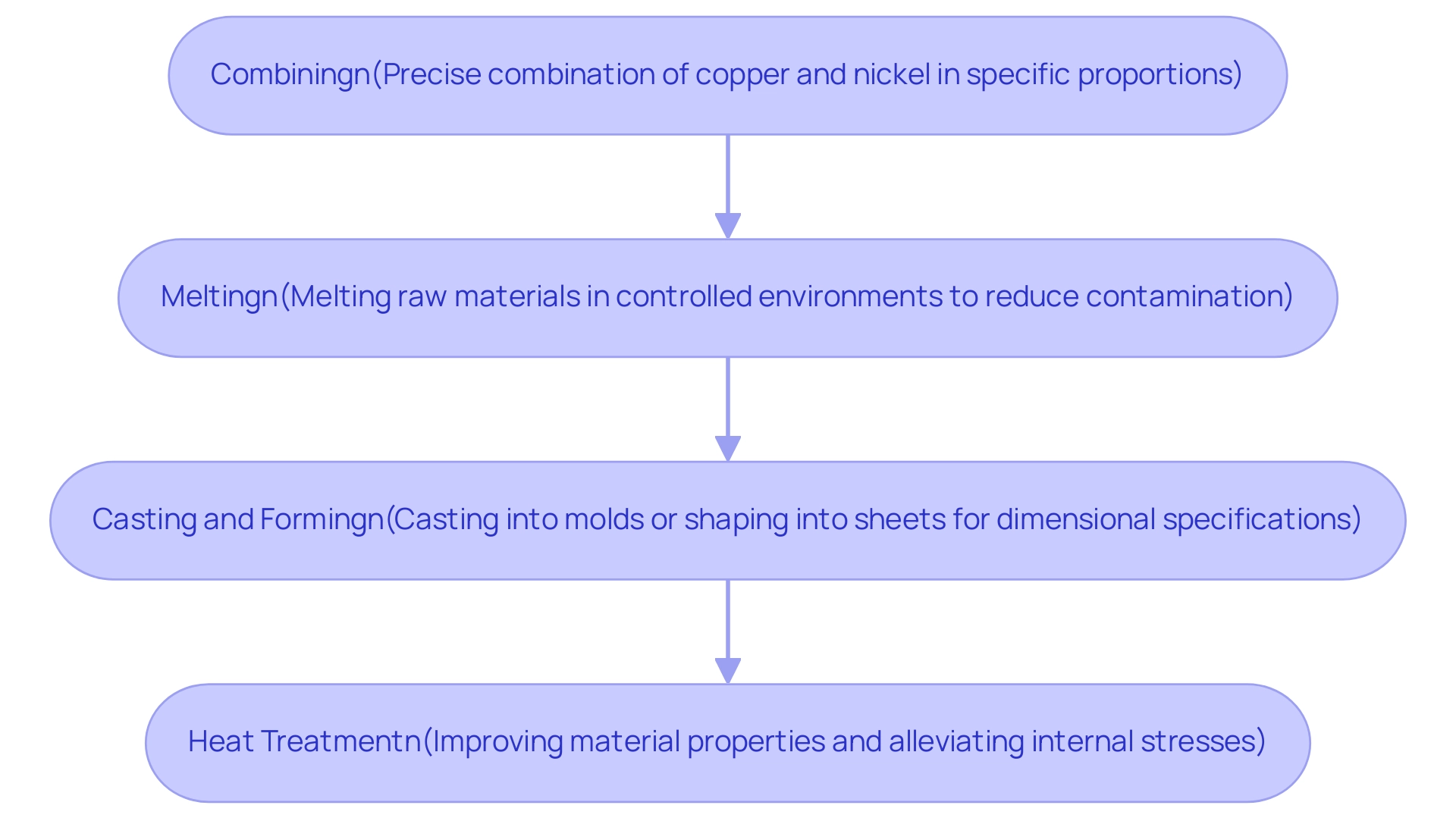
Future Trends in Nickel-Iron Alloys and Magnetic Shielding
As technological advancements reshape various industries, several pivotal trends are influencing the future of nickel-iron materials in magnetic shielding:
- Miniaturization of Electronics: The relentless pursuit of smaller and more efficient components is propelling innovation in formulations. This trend requires the creation of jis c 2531 nickel-iron alloys for magnetic shielding that can satisfy the stringent operational demands of compact designs, highlighting both efficiency and effectiveness. Industry analysts, including those from [Industry Analyst Firm], forecast that as miniaturization progresses, the market will focus more on materials that can provide superior shielding capabilities without compromising size.
- Increased Demand for EMI Shielding: The proliferation of wireless technologies is driving a corresponding growth in the demand for effective electromagnetic interference (EMI) shielding. This offers a chance for manufacturers to create advanced jis c 2531 nickel-iron alloys for magnetic shielding with customized characteristics focused on improving EMI functionality in diverse uses. According to recent statistics from [Relevant Source], the aerospace and automotive industries are significantly contributing to this demand, highlighting the need for specialized materials. As organizations increasingly prioritize the integrity of electronic signals, the need for specialized materials such as jis c 2531 nickel-iron alloys for magnetic shielding will only intensify.
- Sustainability Initiatives: In response to growing environmental concerns, manufacturers are shifting focus towards sustainable practices. This shift has resulted in the creation of recyclable nickel-iron compounds and environmentally friendly production methods. Sustainable manufacturing not only meets regulatory expectations but also appeals to a market increasingly conscious of ecological impacts.
- Integration with Smart Technologies: The incorporation of jis c 2531 nickel-iron alloys for magnetic shielding into smart devices is creating new avenues for application, enhancing functionality and performance. As smart technology continues to evolve, the role of these alloys will expand, integrating seamlessly into next-generation devices and systems.
Understanding these trends allows procurement managers to align their sourcing strategies with industry innovations, ensuring competitiveness and responsiveness to evolving market demands. By anticipating future needs, they can secure their supply chains and foster relationships with manufacturers who are at the forefront of these developments. Furthermore, case studies such as [Case Study Title] illustrate how companies are successfully implementing these trends in their operations, providing a roadmap for others in the industry.
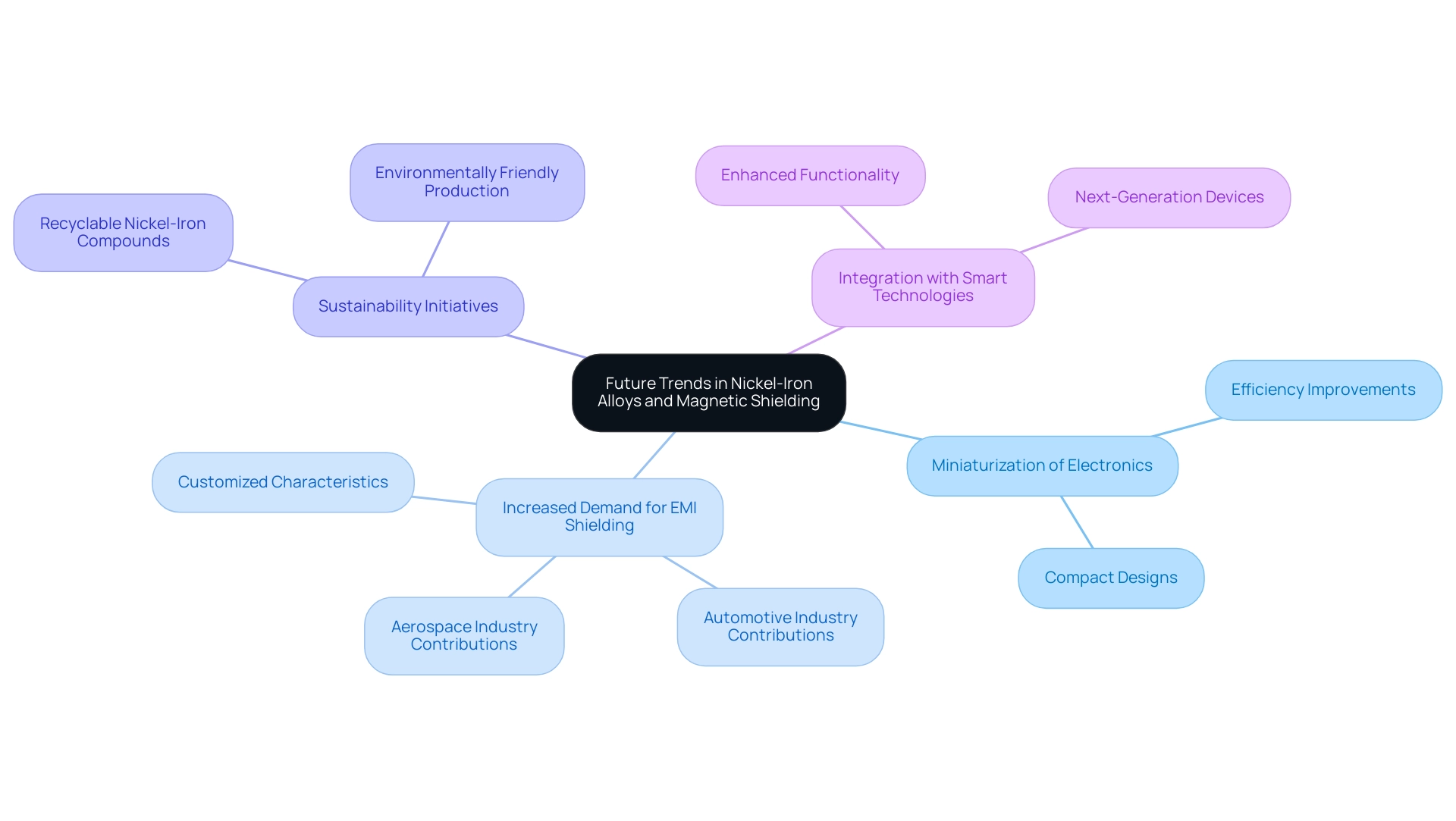
Conclusion
Nickel-iron alloys are integral to modern applications requiring effective magnetic shielding, and a thorough understanding of the JIS C 2531 standard is essential for procurement managers. This standard outlines the critical specifications that these alloys must meet, ensuring not only compliance but also enhanced performance and reliability across various sectors, from consumer electronics to medical devices. The significant improvements in material performance attributed to adherence to these specifications underline the importance of strategic sourcing in maintaining a resilient supply chain.
The unique properties of nickel-iron alloys, such as high permeability, low hysteresis loss, and excellent saturation magnetization, make them particularly suited for mitigating electromagnetic interference. These characteristics empower industries to develop innovative solutions that enhance the functionality and safety of electronic devices, vehicles, and medical equipment. As technology continues to advance, the demand for these alloys will only grow, further emphasizing the need for procurement professionals to stay informed about their evolving applications and benefits.
Looking ahead, trends such as the miniaturization of electronics, increased demand for EMI shielding, and a focus on sustainability are shaping the future landscape of nickel-iron alloys. By leveraging these trends, procurement managers can align their sourcing strategies with industry innovations, ensuring they remain competitive in a rapidly changing market. Ultimately, a strategic approach to sourcing nickel-iron alloys not only enhances product reliability and performance but also fosters long-term partnerships with suppliers who are committed to quality and innovation.




